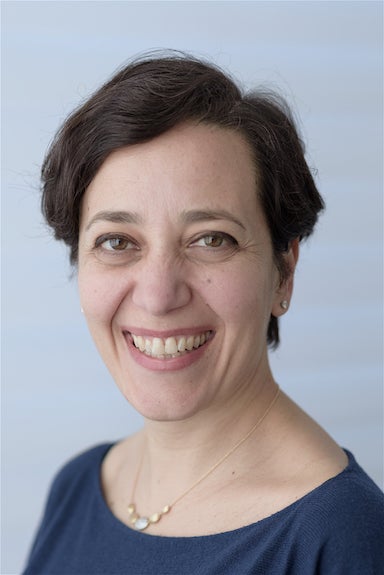Del Gado Team Makes Breakthrough on Abrupt Aging

June 26, 2017 — Georgetown College physics professor Emanuela Del Gado landed a paper in the prestigious journal Nature Communications last week.
“Elastically driven intermittent microscopic dynamics in soft solids,” the culmination of years of research at Georgetown’s Institute of Soft Matter Synthesis and Metrology, found fascinating new properties in the aging of soft materials. Del Gado and her coauthors discovered a “snapping back” reaction that occurs when incredibly soft materials — gelatin or yogurt, for example — rupture at a microscopic level.
Some background: Molecules in soft materials, even seemingly solid ones, “wiggle” at a level imperceptible to the human eye. As time passes, this wiggling can change the material, frequently rupturing or consolidating its structure. Del Gado’s paper noted an interesting reaction to this process.
“Over those very small length scales, these materials can act as a micro rubber band that snaps back when a microscopic rupture happens, Del Gado said. “The weaker the wiggling motion is, the stronger the rubber band snapping.”
To conduct these studies, Del Gado’s team used coarse-grained Molecular Dynamics (MD), an advanced technique that uses computational physics to investigate material properties at the microscopic level. This technique had been used in this context before, but this specific study involved a new simulation strategy — one in which the MD data was combined with an understanding of forces at work at different points in the structure to guess where ruptures would happen.
According to Del Gado, this represents a major development for a question that had stumped researchers for years.
“Why does this abrupt aging happen in certain materials and not in others? How do we explain apparently contradictory observations in different materials that are all, in some sense, soft? These are questions that have been around for more than 10 years — and our work managed to answer the questions and address all contradictions,” she said.
Del Gado has been interested in the “rubber band” effect of abrupt aging since reading and discussing about it during her postdoctoral fellowship, and it hasn’t left her mind since then.
“A few of the studies I have done since then were related to this phenomenon, and I kept discussing about it with colleagues in different parts of the world,” Del Gado said. “But we weren’t able to push the simulations far enough to help disentangle the experiments and the theoretical predictions.”
The more immediate motivation came from discussions at a 2014 conference at UC-Santa Barbara’s Kavli Institute for Theoretical Physics, which pushed her to develop these new simulations, which go beyond theoretical prediction and allow her to predict when ruptures will happen. She also noted important contributions from members of her team: Postdoctoral researcher Mehdi Bouzid was crucial in the whole project, and undergraduate exchange student Lucas Vieira developed a unique visualization tool for the simulations.
Del Gado’s findings will likely help scientists better understand the aging process of soft materials when designing food and personal care products, with potential implications on shelf life. For the layman, she hopes her work underscores the complexity of the soft materials that are so important to everyday life.
“Materials that we already use in our everyday life, and the new materials we try to develop are much more complex microscopically than, say, metals,” Del Gado said. “We need to understand how microscopic dynamics develop in those complex microstructures to design and enhance those materials.”
— Patrick Curran